
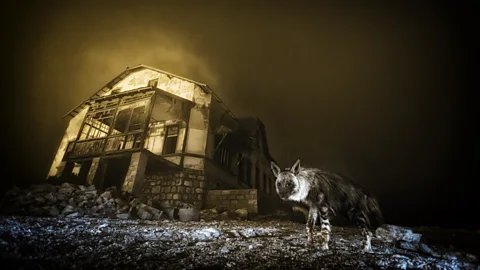 Wim van den Heever
Wim van den Heever
The story behind the award-winning photo of an elusive brown hyena bringing new life to the Namib Desert.
At night, the long-abandoned diamond mining town of Kolmanskop is almost empty. The tourists who visit this early 20th-Century settlement near Namibia's Atlantic Coast for its sand-filled buildings have all gone back to their accommodation for the night. But there is still some movement in the deserted streets. Between the shadowy wrecked buildings and alleyways half submerged in sand, there is the skulking form of a lone brown hyena.
A bright flash illuminates the scene – and marks the culmination of 10 years of work for the South African wildlife photographer Wim van den Heever.
It's the shot that won the grand title at this year's Wildlife Photographer of the Year, run by the Natural History Museum in London. It's an intriguing image not just for its composition, but for its subject too. The brown hyena is the rarest species of hyena in the world. It is also a remarkably adaptive and opportunistic animal, which has adopted Namibia's abandoned diamond towns as its own. (You can see the other winners of the competition here.)

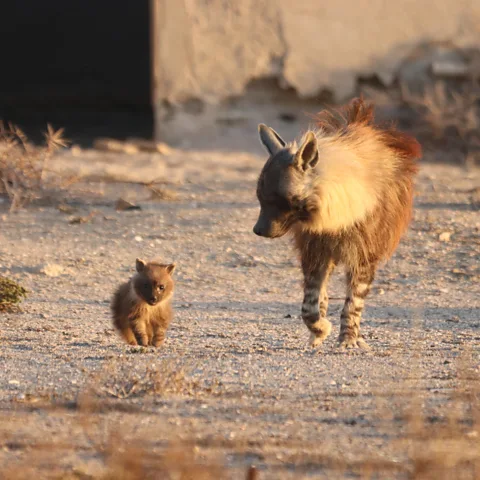 Marie Lemerle
Marie Lemerle
Van den Heever runs nature photography tours around the world and returns to the Namib Desert once a year. During his initial visits, he became convinced that a brown hyena was roaming the ghost town at night. "I would see either droppings or tracks of a hyena in the area," he says. He soon had the idea of photographing the hyena in the striking setting of the ghost town.
After trying several different approaches, Van den Heever settled on waking between 02:00-03:00 to return to Kolmanskop to set up his camera trap while the town was entirely empty. Capturing the shot, however, was exceptionally difficult. The brown hyena is a shy animal, mainly active at night. For years, Van den Heever would only catch a glimpse of one far in the distance from the town, often running in the opposite direction.
Added to that was the daunting environment of the Namib Desert. Easterly winds brought sands that would pile up a metre (3.3ft) high against his photography equipment in the night. "I had one or two years where cameras just got absolutely trashed," he says. When a westerly wind was blowing in off the ocean, it brought thick banks of fog. "Then even if there's a hyena in your picture, you can't see it, because the fog's just too thick."

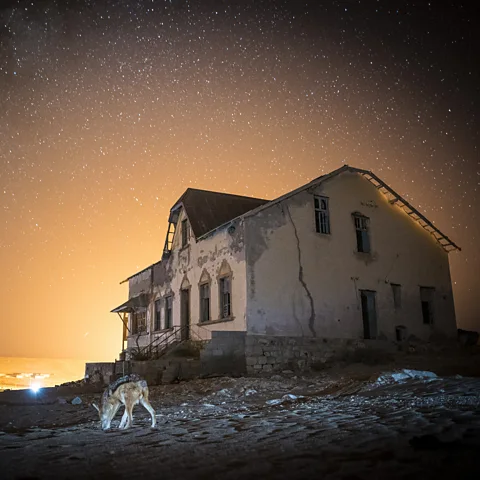 Wim van den Heever
Wim van den Heever
Finally, there was the question of where to put the camera trap. Van den Heever imagined the route a hyena might take while roaming through the abandoned town. "I always had in my mind that if something's going to walk from this direction to this direction, it'll have to come through this plane," says Van den Heever. "And if I can time it correctly, I can get the hyena here, and I can get the house there. And that was basically how I went about choosing the composition and lining up the cameras."
After that, it was a matter of waiting. Ten years of visits to Kolmanskop went by, during which time Van den Heever's camera traps captured a couple of jackals facing the wrong way, but no brown hyena.
Then came the night when the conditions were just right, and the hyena walked exactly where Van den Heever anticipated it might. "My camera triggered three times that night. Once with me testing the scene. The second time, nothing happened, and the third time, there was a hyena in the picture."
He describes being close to tears as he saw the image for the first time on the back of the camera. "It's exactly the way I envisaged the picture to be," he says. "It's exactly what I was looking for from day one. It's why I went through all the effort, all those seasons to try and do it."

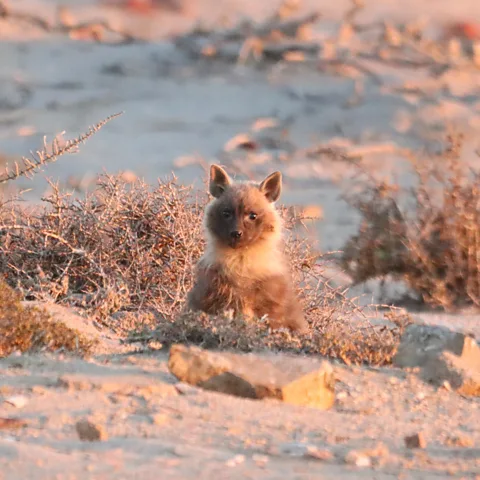 Marie Lemerle
Marie Lemerle
There are thought to be between around 4,370 and 10,110 brown hyenas left in southern Africa, making it the rarest hyena in the world. The species is considered "near threatened", but its numbers are thought to be more or less stable, says Marie Lemerle, who runs the Brown Hyena Research Project based in the town of Lüderitz, about 12km (7.5 miles) from Kolmanskop.
"They're a very elusive species," says Lemerle. "They are probably in a lot of places where people don't really expect them to be." They are also a quiet animal. The more famous spotted hyena has a distinctive call that can carry over long distances, but the brown hyena is nowhere near as vocal. "They can walk past your tent and you might not even hear them," says Lemerle. "You'll just see the tracks the next morning."
Kolmanskop and Lüderitz lie within a national park about the size of New Jersey that was closed off to the public in 1908 due to diamond mining. Although access to the park is no longer as tightly controlled today, it remains "one of these rare places in the world where it's almost a pristine area", says Lemerle.

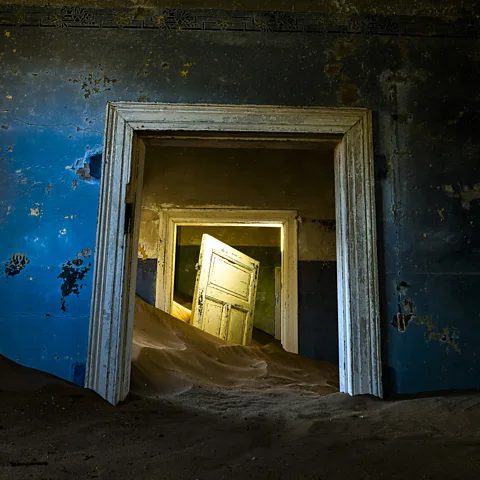 Wim van den Heever
Wim van den Heever
In this area, the brown hyena is the apex predator, mainly feeding on seal pups by the coast. They perform a crucial role in bringing nourishment into the harsh, nutrient-poor environment of the desert, says Lemerle. The abandoned mining towns, too, provide the opportunistic brown hyena with respite from the heat in the exposed, treeless landscape. "The hyenas definitely like to use these old buildings for shelter," she says.
In another abandoned mining town around 30km (20 miles) away, a hyena recently had a cub in the basement of a dilapidated old building. "There was an old kitchen, there was a big old oven at the bottom with some pipes going into the walls, and she used one of these pipes to give birth," says Lemerle. "She actually still uses old pipes and old human-made elements as a den."
These old settlements can be useful to the species, but new developments and roads are one of the main threats brown hyenas face, says Lemerle, with roadkill being one of the main causes of mortality. Outside the park, conflict with humans is another source of mortality, as farmers sometimes treat these scavengers as pests.
"Hyenas in general have a bad reputation," says Lemerle. "Even if brown hyenas aren't usually very successful hunters."
Though they are sometimes seen as "ugly, stinky animals" who do little but cause a nuisance, this reputation is undeserved, Lemerle says. "They actually play a very important role in the ecosystem as scavengers, cleaning the ecosystem of disease and rotting carcasses." (Read more on the wide-ranging benefits of scavengers.)

 Wim van den Heever
Wim van den Heever
Natalie Cooper, a zoologist at the Natural History Museum, hopes that images like Van Den Heever's might help change perceptions of the species. "The image reminds us that humans and wildlife are all part of the environment together, so we need to work together to live alongside them as well."
More broadly, photography can help people bridge gaps in our understanding of the natural world, she says. Global biodiversity is in stark decline due to human activity, but it can be hard for many people to process what that information really means. "I think photographs can really help with making people think," Cooper says.
When reflecting on the 10 years he spent working to get his award-winning shot, Van den Heever laughs. "I put a lot of effort into the picture, and I have to laugh at myself, because that either shows a lot of dedication, or I'm very stupid – I don't know which one."
His recent prize at the Wildlife Photographer of the Year competition may have unequivocally ruled out the latter option, but Van den Heever says he still isn't quite finished with this setting, or this subject.
"There's always something that can be added. The hyena could have had a seal pup in its mouth, it could have been winking at you, there could have been two hyenas… the hyena could have been jumping through the picture. So we always go back, and we always try to do something different," says Van den Heever. "Photographers are never content."
--
For essential climate news and hopeful developments to your inbox, sign up to the Future Earth newsletter, while The Essential List delivers a handpicked selection of features and insights twice a week.
For more science, technology, environment and health stories from the BBC, follow us on Facebook and Instagram.
.png)



